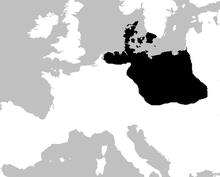漏斗状ビーカー文化
表示
この記事は英語版の対応するページを翻訳することにより充実させることができます。(2021年5月) 翻訳前に重要な指示を読むには右にある[表示]をクリックしてください。
|
 | |
| 分布範囲 | ヨーロッパ |
|---|---|
| 時代 | 新石器時代 |
| 年代 | c. 4300 BC – 2800 BC |
| 先行文化 | |
| 後続文化 | |
漏斗状ビーカー文化(ろうとじょうビーカーぶんか、Funnelbeaker culture、紀元前4300年から2800年頃)は、中央ヨーロッパ中北部の考古文化である。エルベ川下流とヴィスワ川中流の間の現地の新石器時代と中石器時代の技術融合によって発展し、このラインより北に居住する土器使用狩猟採集民に、主要な食料源として農業と畜産をもたらした。
担い手
[編集]漏斗状ビーカー文化人の遺骨の分析から、担い手がY染色体ハプログループI(特にI2a)・R1b等、mtDNAハプログループH・K・T・J・U等に属していることが判明した[1][2][3][4][5][6][7][8][9][10][11]。
土器の写真
[編集]-
Archaeological state museum Schleswig-Holstein, Gottorf Castle
-
Archaeological state museum Schleswig-Holstein, Gottorf Castle
-
Archaeological state museum Schleswig-Holstein, Gottorf Castle
-
Archaeological state museum Schleswig-Holstein, Gottorf Castle
脚注
[編集]- ^ Malmström, Helena; et al. (November 3, 2009). "Ancient DNA Reveals Lack of Continuity between Neolithic Hunter-Gatherers and Contemporary Scandinavians". Current Biology. Cell Press. 19 (20): 1758–62. doi:10.1016/j.cub.2009.09.017. PMID 19781941. S2CID 9487217.
- ^ Skoglund, Pontus; et al. (April 27, 2012). "Origins and Genetic Legacy of Neolithic Farmers and Hunter-Gatherers in Europe". Science. American Association for the Advancement of Science. 336 (6080): 466–469. doi:10.1126/science.1216304. PMID 22539720. S2CID 13371609.
- ^ Skoglund, Pontus; et al. (May 16, 2014). "Genomic Diversity and Admixture Differs for Stone-Age Scandinavian Foragers and Farmers". Science. American Association for the Advancement of Science. 344 (6185): 747–750. doi:10.1126/science.1253448. PMID 24762536. S2CID 206556994.
- ^ Malmström, Helena; et al. (January 19, 2015). "Ancient mitochondrial DNA from the northern fringe of the Neolithic farming expansion in Europe sheds light on the dispersion process". Proceedings of the Royal Society B. Royal Society. 370 (1660). doi:10.1098/rstb.2013.0373. PMC 4275881. PMID 25487325.
- ^ Haak, Wolfgang; et al. (March 2, 2015). "Massive migration from the steppe was a source for Indo-European languages in Europe". Nature. Nature Research. 522 (7555): 207–211. doi:10.1038/nature14317. PMC 5048219. PMID 25731166.
- ^ Mathieson, Iain; et al. (February 21, 2018). "The genomic history of southeastern Europe". Nature. Nature Research. 555 (7695): 197–203. doi:10.1038/nature25778. PMC 6091220. PMID 29466330.
- ^ Lipson, Mark; et al. (November 8, 2017). "Parallel palaeogenomic transects reveal complex genetic history of early European farmers". Nature. Nature Research. 551 (7680): 368–372. doi:10.1038/nature24476. PMC 5973800. PMID 29144465.
- ^ Narasimhan, Vagheesh M.; et al. (September 6, 2019). "The formation of human populations in South and Central Asia". Science. American Association for the Advancement of Science. 365 (6457): 1230–1234. doi:10.1126/science.aat7487. PMC 6822619. PMID 31488661.
- ^ Mittnik, Alissa; et al. (January 30, 2018). "The genetic prehistory of the Baltic Sea region". Nature Communications. Nature Research. 9 (442): 442. doi:10.1038/s41467-018-02825-9. PMC 5789860. PMID 29382937.
- ^ Sánchez-Quinto, Federico; et al. (May 7, 2019). "Megalithic tombs in western and northern Neolithic Europe were linked to a kindred society". Proceedings of the National Academy of Sciences of the United States of America. National Academy of Sciences. 116 (19): 9469–9474. doi:10.1073/pnas.1818037116. PMC 6511028. PMID 30988179.
- ^ Malmström, Helena; et al. (October 9, 2019). "The genomic ancestry of the Scandinavian Battle Axe Culture people and their relation to the broader Corded Ware horizon". Proceedings of the Royal Society B. Royal Society. 286 (1912): 20191528. doi:10.1098/rspb.2019.1528. PMC 6790770. PMID 31594508.





